Exploring the resurgence of wood paneling in home design reveals a transformation from its traditional roots to its new, chic status in contemporary decor. Modern wood paneling is no longer the dark, dated feature of past decades but a vibrant and versatile element that can add warmth, texture, and sophistication to any space. Today’s paneling techniques and materials offer a fresh and modern twist, making wood paneling a coveted feature in interior design projects. This versatile decor element seamlessly blends the warmth of natural wood with the clean lines and minimalist aesthetics of modern design, proving that old and new can coexist beautifully.
Sleek Elegance: Modern Wood Paneling for Minimalist Spaces

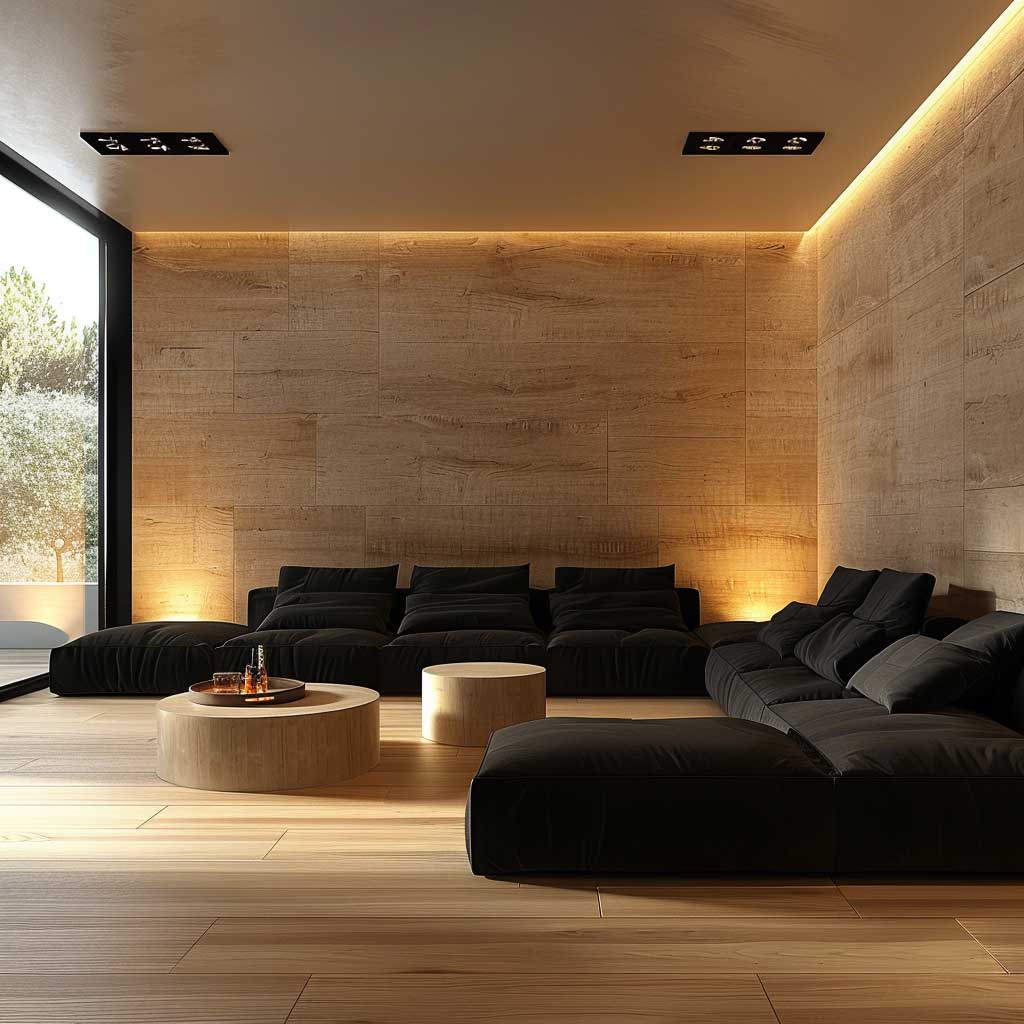


In the world of contemporary interior design, the fusion of minimalist aesthetics with natural elements has emerged as a trend that not only endures but evolves. At the forefront of this evolution is the integration of modern wood paneling into minimalist spaces, a design choice that marries simplicity with warmth, creating environments that are both serene and inviting. This essay delves into how modern wood paneling is revolutionizing minimalist interiors, transforming them into spaces that speak volumes through their understated elegance.
Modern wood paneling, with its sleek lines and refined textures, serves as a testament to the beauty of restraint. Unlike the dark, heavy paneling of decades past, today’s wood paneling is light, airy, and infused with a sense of openness. It’s designed to complement the minimalist ethos, where every element in a room is intentional and serves a purpose. This form of paneling uses clean, horizontal or vertical lines to draw the eye, elongating or widening a space visually and infusing it with a natural flow that’s both calming and compelling.
The choice of wood in these minimalist designs is crucial. Lighter woods like birch, maple, and ash are favored for their ability to reflect natural light, enhancing the sense of space and purity in a room. The natural finish of the wood, often matte or with a subtle sheen, celebrates the intrinsic beauty of the material—its grain, texture, and subtle color variations. This celebration of natural beauty is a hallmark of modern design, emphasizing authenticity and a connection to the natural world.
Incorporating modern wood paneling into a minimalist space requires a careful balancing act. The paneling must not overwhelm but rather complement the space’s clean lines and sparse furnishings. Furniture in such spaces often features sleek, geometric forms and a neutral color palette that mirrors the simplicity and natural hues of the wood paneling. This synergy between the paneling and furniture creates a cohesive look that’s both sophisticated and tranquil.

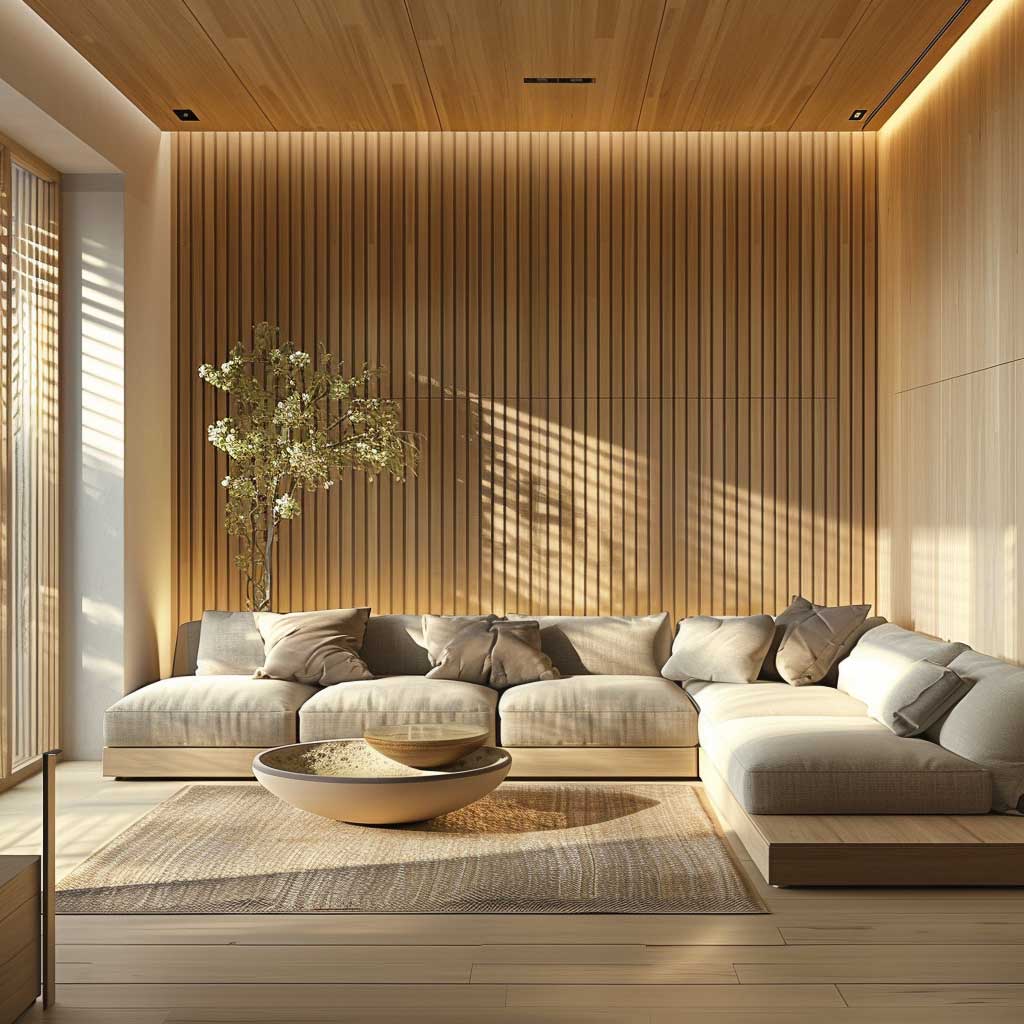
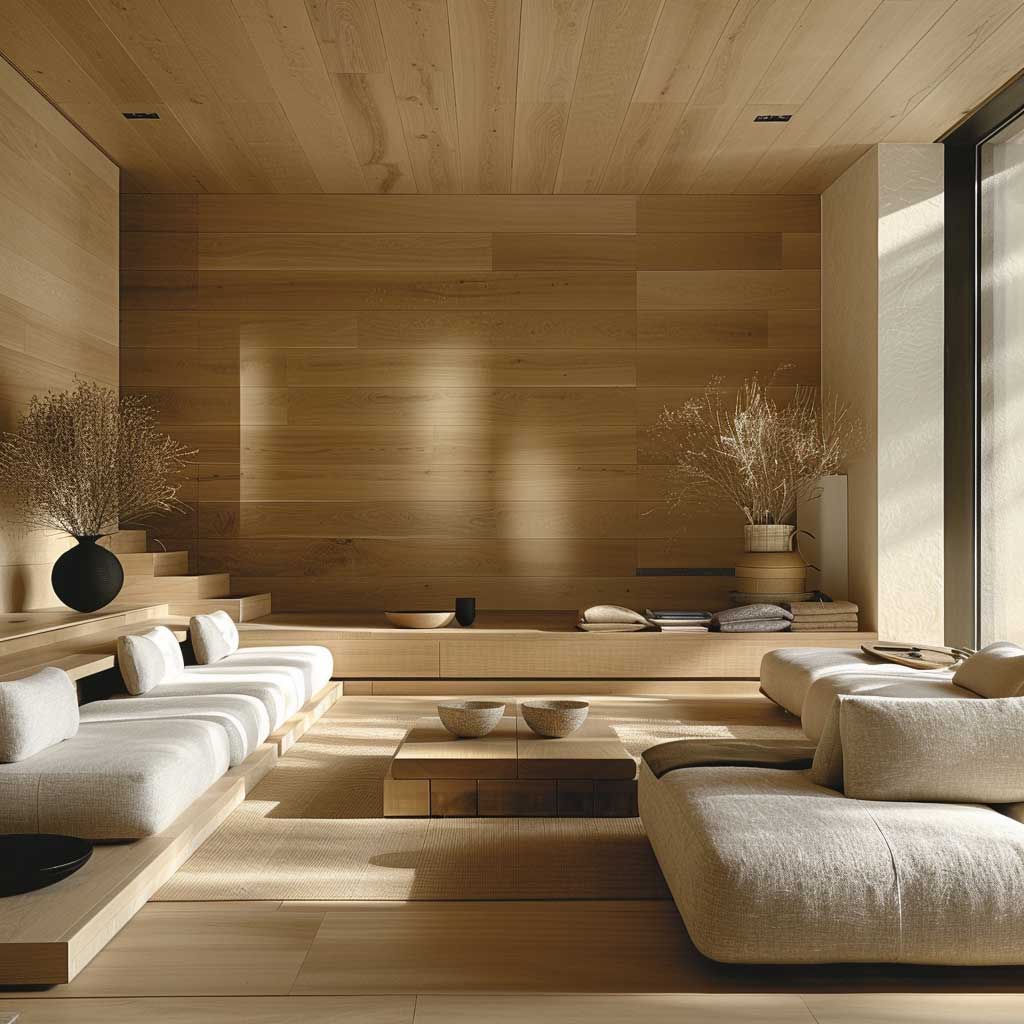

Lighting plays a pivotal role in bringing the best out of modern wood paneling in minimalist settings. Natural lighting is maximized to enhance the warmth of the wood and create a bright, welcoming atmosphere. When it comes to artificial lighting, the approach is strategic, with fixtures placed to highlight the texture and grain of the wood, adding depth and interest to the space. This thoughtful integration of lighting with wood paneling underscores the minimalist principle that design should not only be beautiful but also functional.
The appeal of modern wood paneling in minimalist spaces extends beyond aesthetics to the psychological impact on inhabitants. Spaces designed with a minimalist approach are known for their calming effect, reducing clutter not just physically but also visually and mentally. The addition of wood paneling adds warmth and texture, making these clean, open spaces feel more grounded and inviting. It’s a design choice that speaks to our innate connection to nature, bringing a sense of peace and comfort to our living environments.
Moreover, modern wood paneling is a reflection of the growing desire for sustainability and eco-friendliness in interior design. Many designers and homeowners now opt for paneling made from reclaimed or sustainably sourced wood, aligning with the minimalist ethos of mindful consumption and respect for the environment. This conscious choice reinforces the idea that beauty and responsibility can go hand in hand, creating spaces that are not only visually stunning but also ethically grounded.
In conclusion, the integration of modern wood paneling into minimalist spaces represents a confluence of form, function, and philosophy. It demonstrates how simplicity can be warm and inviting, how natural elements can transform a space, and how design can be both beautiful and meaningful. As we continue to explore the possibilities of modern interior design, the use of wood paneling in minimalist settings stands out as a beacon of elegance, simplicity, and sustainability.
Rustic Meets Modern: Wood Paneling in Contemporary Kitchens




In the ever-evolving world of interior design, the kitchen stands as a testament to both functionality and aesthetic appeal. The heart of the home, where meals are prepared and memories are made, has seen a remarkable transformation in recent years. This transformation is partly due to the innovative use of materials and design philosophies that blend the old with the new. A prime example of this blend is the incorporation of modern wood paneling in contemporary kitchens, where the rustic charm of wood meets the sleek efficiency of modern design, creating spaces that are both inviting and stylish.
Modern wood paneling in contemporary kitchens is not about recreating the past but rather reimagining the role of wood in a modern context. Gone are the days of dark, oppressive wood paneling that felt more like a relic than a design choice. Today’s wood paneling is light, versatile, and tailored to fit the unique aesthetics of each kitchen. It brings warmth and texture to the space, serving as a counterpoint to the clean lines of modern cabinetry and the smooth surfaces of state-of-the-art appliances. This juxtaposition of rustic wood with modern elements creates a dynamic interplay that enriches the kitchen’s overall design.
One of the key aspects of using wood paneling in contemporary kitchens is the choice of wood and finish. Designers often opt for reclaimed or sustainably sourced wood, which not only adds character to the kitchen but also speaks to a growing concern for environmental sustainability. The finishes range from raw and natural to lightly stained, preserving the wood’s texture and grain. This natural beauty of wood brings an organic, earthy feel to the kitchen, making it more welcoming and comfortable.
The versatility of modern wood paneling allows for a variety of applications in the kitchen. It can be used as a striking backsplash, a feature wall, or even as paneling for kitchen islands. Each application offers a unique way to incorporate wood into the kitchen, allowing for creativity and personalization. For instance, a wood-paneled backsplash adds a touch of warmth to a kitchen dominated by cool tones, while a wood-paneled island becomes a focal point, drawing the eye and inviting conversation.

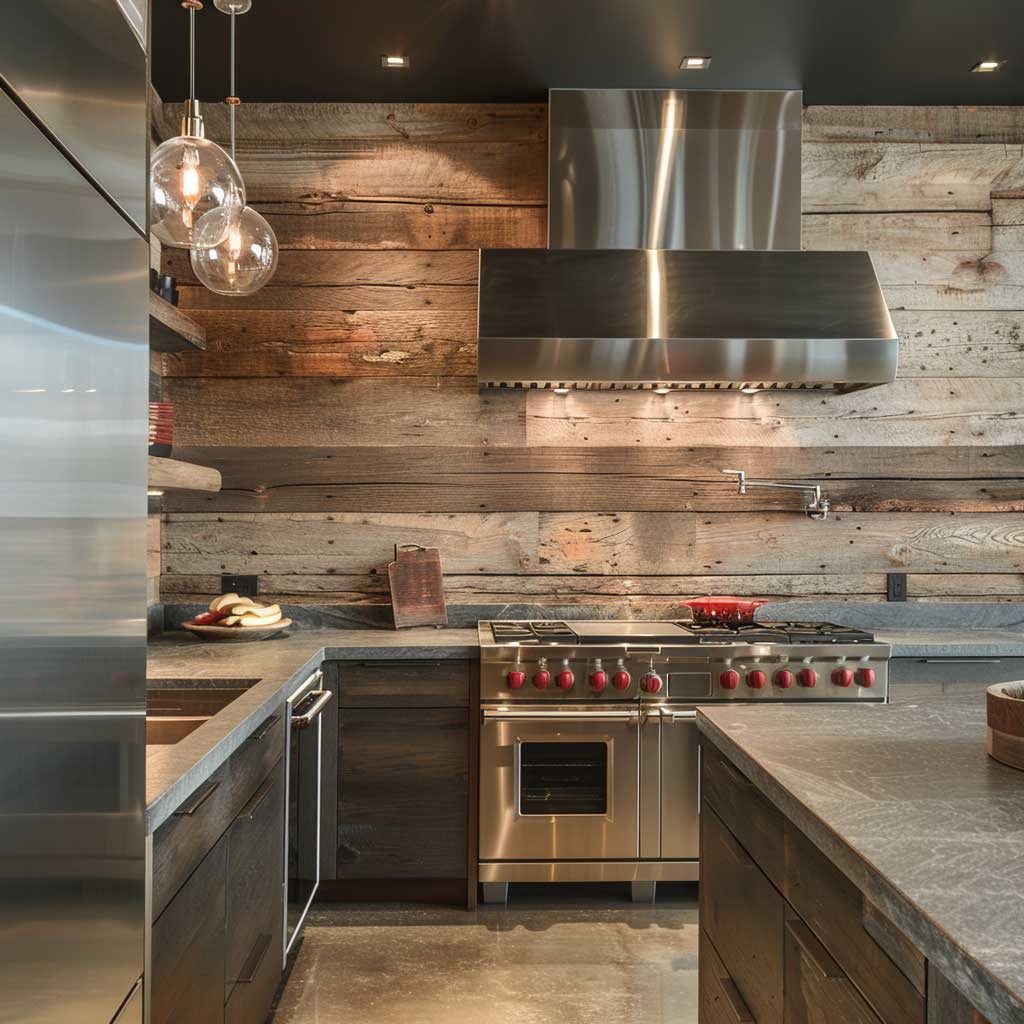


Lighting plays a crucial role in showcasing the beauty of wood paneling in the kitchen. Strategic lighting, whether natural or artificial, can highlight the texture and color variations in the wood, adding depth and dimension to the space. Pendant lights over a wood-paneled island or under-cabinet lighting that illuminates a wood backsplash can transform the wood from a mere material to a feature that adds ambiance and warmth to the kitchen.
The integration of modern wood paneling in contemporary kitchens also reflects a broader trend towards personalization and storytelling in interior design. Each piece of wood, with its unique grain and history, tells a story, adding a layer of depth and interest to the kitchen. Homeowners are increasingly drawn to designs that reflect their personality and values, and the use of wood paneling offers an opportunity to infuse the kitchen with individuality and warmth.
Moreover, modern wood paneling challenges the notion that contemporary design must be cold and impersonal. By incorporating wood, a material with inherent warmth and character, into the kitchen, designers can create spaces that are modern yet inviting. This approach to kitchen design aligns with the desire for homes that are not just visually appealing but also emotionally resonant, where the kitchen is not just a place to cook but a space to gather, share, and connect.
In conclusion, the rustic meets modern approach to wood paneling in contemporary kitchens represents a harmonious blend of tradition and innovation. It is a testament to the versatility of wood as a material and the creativity of modern design. As kitchens continue to evolve as the centerpiece of the home, the thoughtful incorporation of wood paneling stands as a reminder of the power of design to transform not just spaces but also the experiences and memories we create within them.
Bold and Textured: Dramatic Wood Paneling in Modern Bedrooms
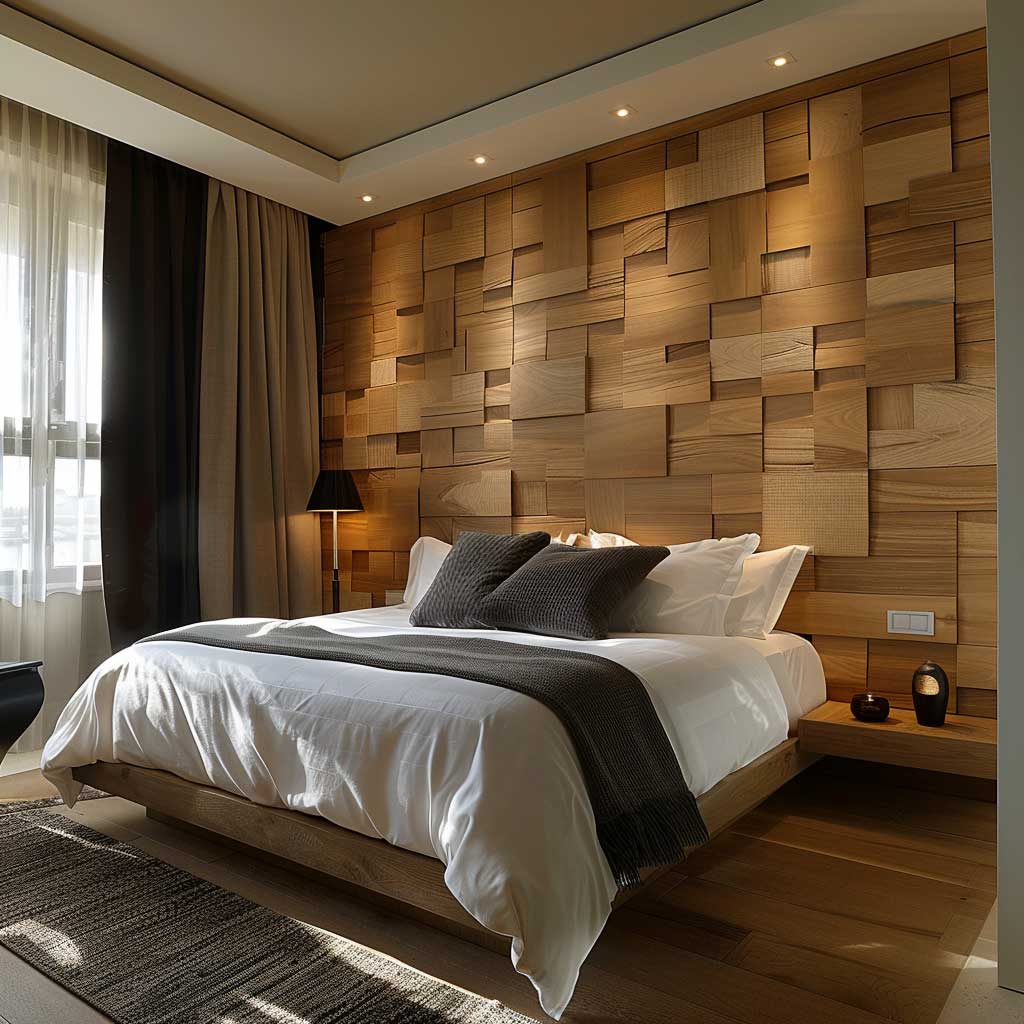



In the sanctuary of the modern bedroom, where tranquility meets personal style, an emerging design trend is captivating the imagination of homeowners and designers alike. This trend involves the bold and textured use of modern wood paneling, transforming ordinary spaces into dramatic retreats that invite relaxation and reflection. Far from the flat and featureless walls of the past, today’s wood paneling is a canvas for creativity, offering depth, warmth, and a tactile dimension that enhances the sensory experience of the bedroom.
The evolution of wood paneling from a traditional decorative element to a modern design statement reflects a broader shift in interior design towards materials that offer both aesthetic appeal and emotional resonance. In the modern bedroom, wood paneling serves not just as a backdrop but as a focal point, drawing the eye with its bold textures and rich hues. This dramatic use of wood is a departure from the minimalist approach often associated with contemporary design, showcasing the versatility of wood as a material that can convey both simplicity and complexity.
One of the hallmarks of this design trend is the variety of textures that can be achieved with modern wood paneling. Designers are experimenting with different techniques, from carving and etching to stacking and layering, to create paneling that is visually intriguing and tactilely engaging. These textured surfaces play with light and shadow, changing appearance throughout the day and adding a dynamic quality to the bedroom. The result is a space that feels alive, a room that has character and depth beyond its four walls.
Color also plays a significant role in the bold and textured approach to wood paneling. While natural wood tones remain popular for their warmth and versatility, there is a growing interest in stained or painted wood that adds a dramatic flair to the bedroom. Deep blues, rich greens, and even bold blacks are being used to accentuate the texture of the wood and create a statement wall that anchors the room. This departure from traditional wood tones allows for greater personalization of the space, reflecting the individual’s style and mood.
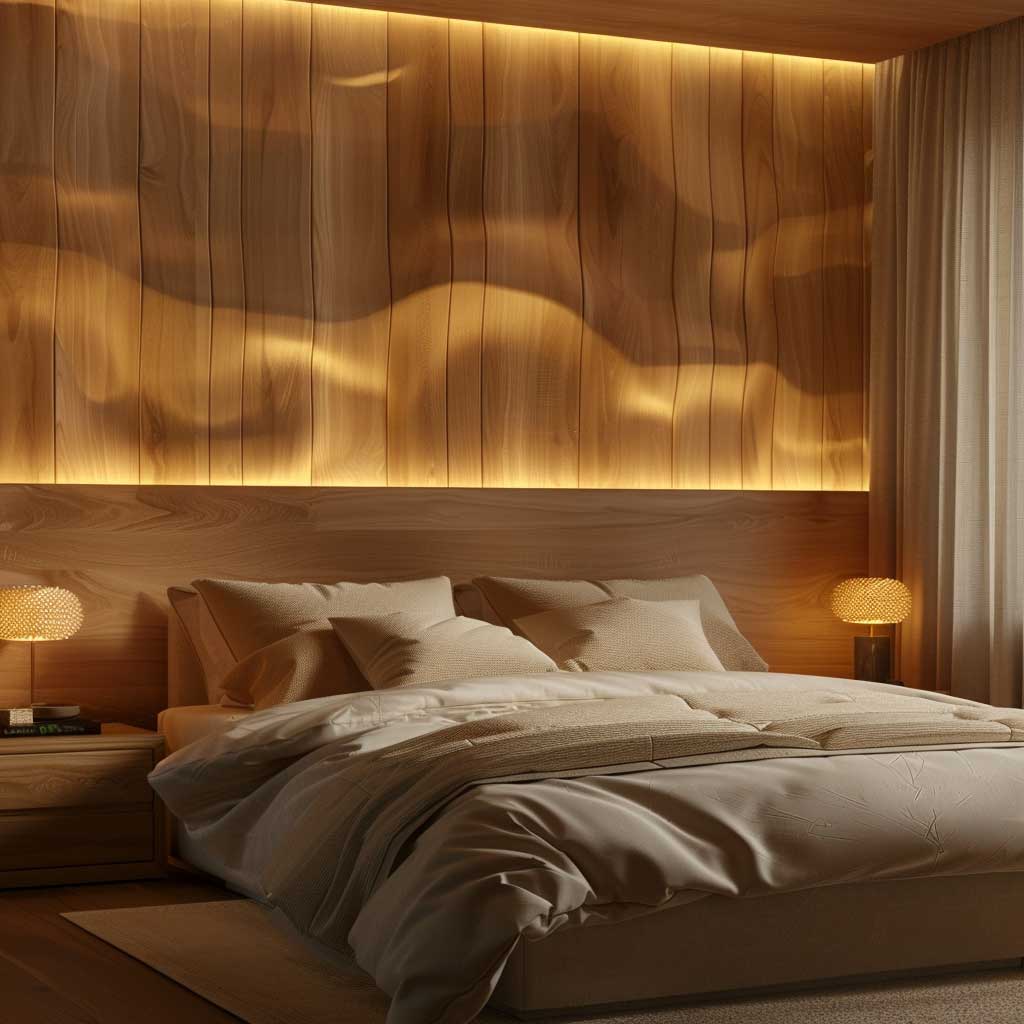
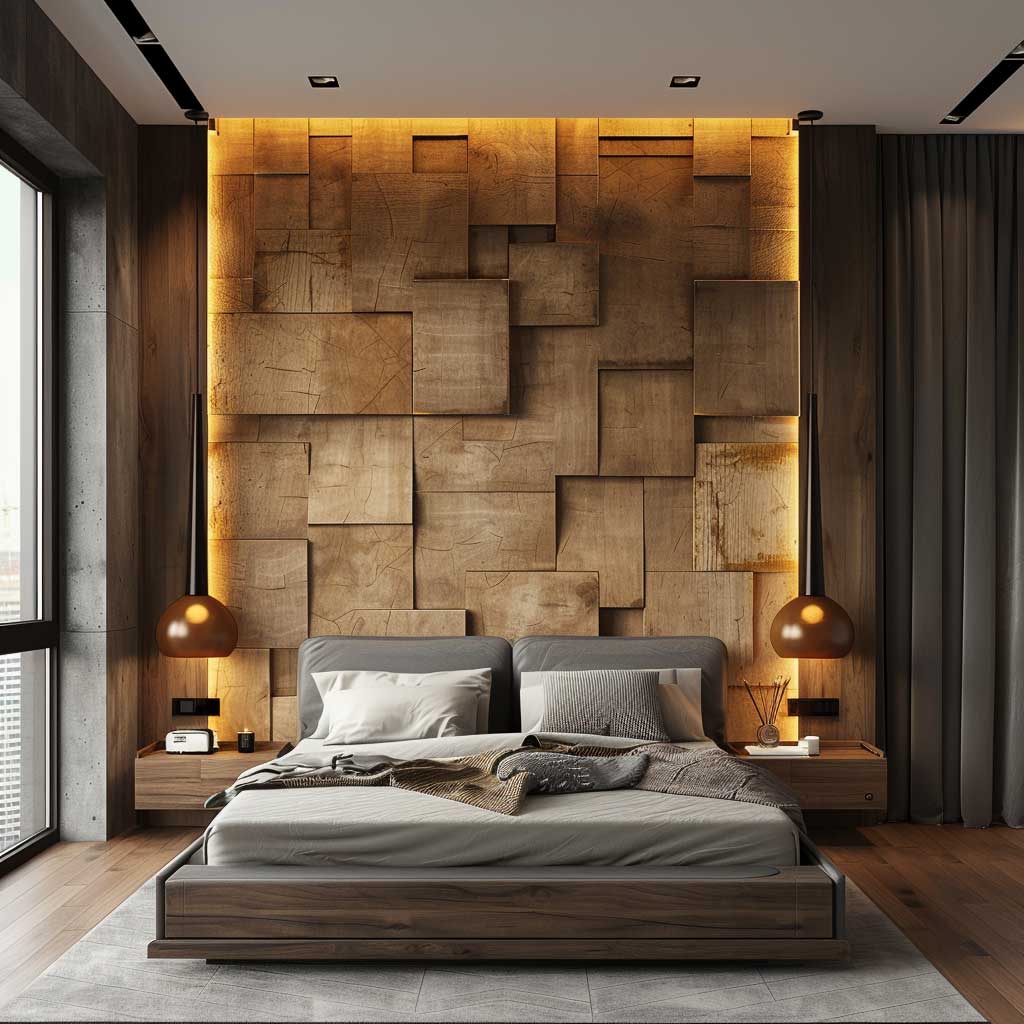


The strategic use of lighting further enhances the dramatic effect of textured wood paneling in the bedroom. Accent lighting, whether through recessed lights, sconces, or strategically placed lamps, can highlight the peaks and valleys of the wood’s texture, creating a play of light and shadow that adds depth and intrigue to the space. This interplay between light and wood becomes a central design element, transforming the bedroom into a space that feels both intimate and expansive.
Incorporating bold and textured wood paneling into the bedroom also speaks to a desire for spaces that engage all the senses. The tactile nature of textured wood invites touch, adding a layer of physical engagement with the space that is often missing in more sterile or minimalist designs. The visual warmth of wood, coupled with its natural grain and imperfections, adds a sense of comfort and connection to the natural world, creating a bedroom that is not just a place to sleep but a retreat for relaxation and rejuvenation.
Moreover, this approach to wood paneling reflects a growing appreciation for craftsmanship and materiality in modern design. In a world where mass-produced and synthetic materials are ubiquitous, the unique textures and colors of wood paneling offer a connection to the artisanal and the authentic. Each panel tells a story of its origin, from the forest to the sawmill to the craftsman’s workshop, adding a layer of meaning and value to the bedroom that goes beyond mere decoration.
In conclusion, the bold and textured use of modern wood paneling in bedrooms represents a sophisticated blend of drama and comfort, innovation and tradition. It is a testament to the enduring appeal of wood as a material that can adapt to various design philosophies, embodying both the rustic and the refined. As homeowners and designers continue to explore the possibilities of wood paneling, the bedroom emerges as a canvas for self-expression, a space where the dramatic interplay of texture, color, and light creates a sanctuary that is deeply personal and profoundly peaceful.
Modern wood paneling has revolutionized interior design, offering endless possibilities for creating spaces that are both stylish and inviting. This design element bridges the gap between the warmth and natural beauty of wood and the clean, crisp lines of contemporary decor. Whether incorporated into a minimalist living room, a contemporary kitchen, or a cozy bedroom, wood paneling adds texture, depth, and character to any space. As we continue to explore and embrace the versatility of wood in modern interior design, it becomes clear that the art of wood paneling is a key element in creating vibrant, dynamic, and harmonious spaces.












